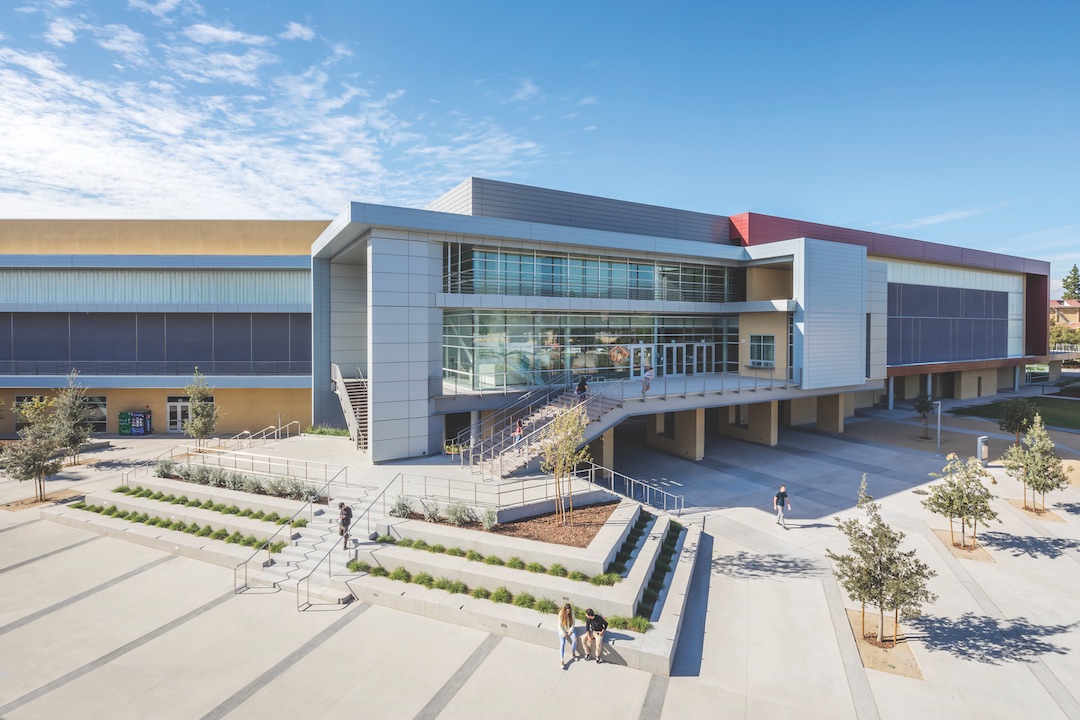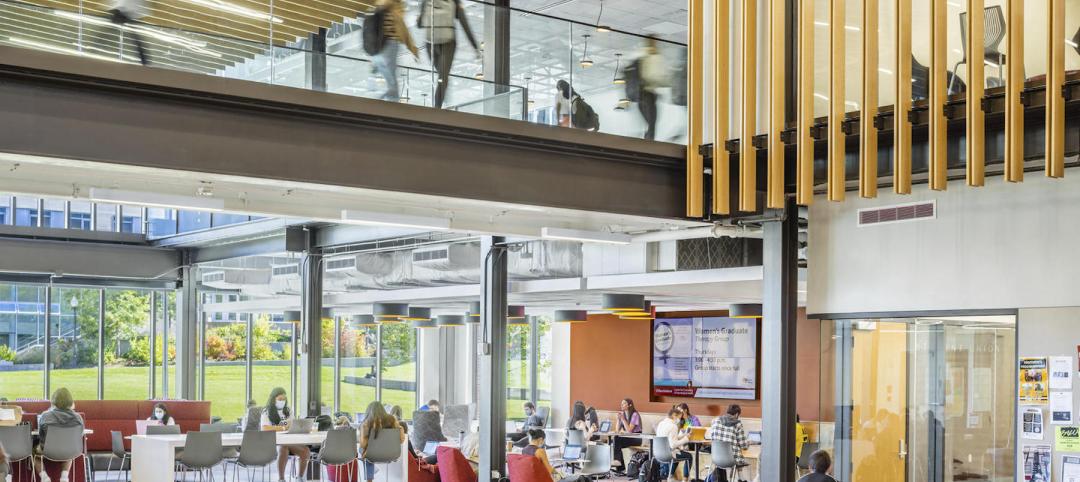Work in the higher education market is steady, but uneven geographically. The South and West are the hottest markets, with the Northeast and Midwest lagging a bit.
Nationwide, demand is most robust for housing and interdisciplinary academic and research buildings. Overall higher education construction spending is projected to increase 1.6% in 2018, the lowest increase reported in the last five years, according to the Center for the Study of Education Policy at Illinois State University.
Though the U.S. economy is strong with investment gains buoying endowments, colleges and universities face pressures to economize and stretch their capital budgets. “Declining enrollment in the last few years is creating financial issues in mid-tier institutions,” says John Baxter, AIA, LEED AP, Higher Education Sector Leader with EYP Architecture and Engineering. This has prompted some closures and mergers, though large, well-endowed institutions are doing fine, he adds.
See also: Top 175 University Architecture + AE Firms - 2018 Giants 300 rankings
See also: Top 90 University Engineering + EA Firms - 2018 Giants 300 rankings
See also: Top 105 University Construction + CM Firms - 2018 Giants 300 rankings
Sponsored by Viracon
One new drag on the revenue side has been Trump Administration policies making it more difficult for foreign students to obtain visas to study in the U.S. “Colleges had been relying on the financial stream from international students,” says Baxter. The drop in international enrollment will probably be temporary, he adds.
Demand for modernized housing and STEM research facilities persists, but this trend is being tempered with an overriding sense of caution. “Clients are being more conservative,” says Patricia Bou, AIA, LEED AP, Principal with CannonDesign. “They are scared to overbuild.”
As a result, many schools are engaging in more detailed master planning of student housing, says Chris Brasier, FAIA, LEED AP, Design Director and Principal with Clark Nexsen. “This includes evaluating existing
buildings and considering off-campus competition,” he says. Housing master planning typically includes financial modeling and detailed market analysis.
For Orange Coast College, a two-year institution in Costa Mesa, Calif., construction of new housing is part of a marketing strategy. Located in pricey Orange County, OCC will become the first community college in the Golden State to build campus housing.
“They are trying to attract more students, and one way to do that is to offer lower-cost housing,” says Paul Kearney, LEED AP, Associate Partner with MVE Architects. As a tax-exempt entity, the college can build for less than a private developer, enabling the school to undercut apartment rentals. The project, now in the construction documents stage, will include student lounges and administrative offices on the 15,000-sf ground floor that will welcome commuter students as well as residents.
The past decade saw a wave of housing projects catering to upperclassmen. Now there’s growth in student housing developments geared for freshmen and sophomores, says Peter Aranyi, AIA, Principal with Clark Nexsen. These units tend to have traditional double-occupancy or suite-style designs, in contrast to individual bedrooms and apartment-style units that had been in vogue in recent years. Newer projects for underclassmen often include community-style bathrooms of old with a twist: private shower and toilet facilities. Common vanity sinks offer space where students see and interact with each other.
Look for universities to focus more on helping students make ends meet over the next few years. A recent online survey of Massachusetts college students by the Wisconsin HOPE Lab found that nearly half of the state’s community college students and a third of the in-state college students cannot afford consistent access to food and housing. Those conditions are not uncommon to the Bay State.
Demand for modernized housing and STEM research facilities persists, but this trend is being tempered with an overriding sense of caution. ‘Clients are being more conservative. They are scared to overbuild,’ says Patricia Bou, AIA, LEED AP, Principal with CannonDesign.
“The newer generation of students is looking to be prudent with their money,” says Baxter. This portends a trend to less luxurious residence halls. “I think you’ll start to see a wave of residences that are more economical than we were seeing five years ago,” Baxter adds.
Public-private partnerships continue to gain ground in the student housing space. Providing an alternative funding method that allows development without taking on new debt, P3s are also becoming an increasingly common engine powering new academic and specialty research lab projects.
A new take on the P3 concept is mission-oriented interdisciplinary facilities. EYP is in the early stages of designing a building to house an institute dedicated to solving some of the planet’s most critical issues such as increased food production, air pollution, and water pollution.
“They want to bring together ag science, veterinary science, engineering, social scientists, and others to collaborate in one building,” says Baxter. “It will not be owned by a department or college. It’s going to be an extraordinary building that can attract corporate partners, because research will be going on that can provide real world solutions.”
A notable public/not-for-profit partnership saw Wingate University and Blue Ridge Community College team up with Henderson County, the City of Hendersonville, and Pardee UNC Health Care to develop the Henderson Health Sciences Center. Located on Wingate’s campus, the $32 million building opened in fall 2016. It houses Pardee Hospital’s Cancer Center and Surgical Clinic, Wingate’s Pharmacy and Physician Assistant programs, and Blue Ridge Community College’s Nursing and Surgical Technology programs.
“It provides a connection between academy and practice,” says Brasier. Students have access to internships and professional instruction along with academic classes in the same building. Higher ed institutions are increasingly looking for these types of innovative partnerships to bolster their offerings backed by partners who contribute to capital projects.
Having grown up with mobile phones and tablets, Generation Z is known for socializing online but with fewer person-to-person interactions than students of the past. Colleges are taking note and trying to provide more spaces for impromptu socialization. Sightlines and wayfinding are important for these spaces to be used as intended. “A lot of it is having the places known,” says Ken Salyer, AIA, Principal and Higher Education Practice Leader with HMC Architects. “We try to make it evident where those places are.” Alcoves with soft furniture and even diner-style booths located off of corridors help to fill this need.
On many campuses, master planning includes a focus on “rightsizing and rightplacing,” says Bou. Cramped for space, many institutions in recent years assigned programs and administrative functions to wherever they would fit. “They are now looking to put things where they belong instead of just where they fit,” says Bou.
A new project in the works at Virginia Tech is a case in point. The university is planning a comprehensive wellness facility that will bring services for physical and mental health, along with clinical services, into one building.
Another trend of note: renovation of the academic workplace, especially at business schools. With most business school instructors coming from corporate environments, they are accustomed to modern workplaces, says Bou. Providing semi-private offices, even if they are small, with transparent sightlines and touchdown spaces of different sizes nearby for meetings, can help woo top talent from the corporate world.
Related Stories
Giants 400 | Aug 21, 2022
Top 110 Architecture/Engineering Firms for 2022
Stantec, HDR, HOK, and Skidmore, Owings & Merrill top the rankings of the nation's largest architecture engineering (AE) firms for nonresidential and multifamily buildings work, as reported in Building Design+Construction's 2022 Giants 400 Report.
Giants 400 | Aug 20, 2022
Top 180 Architecture Firms for 2022
Gensler, Perkins and Will, HKS, and Perkins Eastman top the rankings of the nation's largest architecture firms for nonresidential and multifamily buildings work, as reported in Building Design+Construction's 2022 Giants 400 Report.
Giants 400 | Aug 19, 2022
2022 Giants 400 Report: Tracking the nation's largest architecture, engineering, and construction firms
Now 46 years running, Building Design+Construction's 2022 Giants 400 Report rankings the largest architecture, engineering, and construction firms in the U.S. This year a record 519 AEC firms participated in BD+C's Giants 400 report. The final report includes more than 130 rankings across 25 building sectors and specialty categories.
Daylighting | Aug 18, 2022
Lisa Heschong on 'Thermal and Visual Delight in Architecture'
Lisa Heschong, FIES, discusses her books, "Thermal Delight in Architecture" and "Visual Delight in Architecture," with BD+C's Rob Cassidy.
AEC Tech | Aug 8, 2022
The technology balancing act
As our world reopens from COVID isolation, we are entering back into undefined territory – a form of hybrid existence.
Multifamily Housing | Aug 4, 2022
Faculty housing: A powerful recruitment tool for universities
Recruitment is a growing issue for employers located in areas with a diminishing inventory of affordable housing.
University Buildings | Jul 11, 2022
Student life design impacts campus wellness
As interior designers, we have the opportunity and responsibility to help students achieve deeper levels of engagement in their learning, social involvement, and personal growth on college campuses.
University Buildings | Jul 6, 2022
Wenzhou-Kean University opens a campus building that bridges China’s past and future
After pandemic-related stops and starts, Wenzhou-Kean University’s Ge Hekai Hall has finally begun to see full occupancy.
University Buildings | Jun 9, 2022
IDEA Factory at U. of Maryland defies gravity
The E.A. Fernandez IDEA Factory at the University of Maryland’s A. James Clark School of Engineering has a gravity-defying form: The seven-story building’s solid upper floors emerge above the lighter, mostly glass base.
University Buildings | Jun 7, 2022
Newfoundland university STEM building emulates natural elements, local traditions
Memorial University of Newfoundland (MUN) recently opened a new building that will provide interdisciplinary learning and research space for Faculties of Science and Engineering.

















